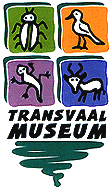
The Transvaal Museum index
click
Transvaal Museum
Paul Kruger Street
SOUTH AFRICA
Tel:
Fax:
Transvaal Museum History
DATE MUSEUM WAS FOUNDED: 1892
The Staatsmuseum was formally constituted on the 1 December 1892. Its creation can be attributed to the initiative of the Secretary of State of the Zuid-Afrikaansche Republiek (South African Republic), Dr W. J. Leyds. The State Museum was first housed in a small room next to the clock tower on the top floor of the Raadsaal (Parliament House). The collection was so small that it was difficult to justify employing permanent staff. Due to public interest the necessity of classifying and sorting the objects became apparent. The collecting policy of the Museum covered cultural history and natural history. To expand the collection two circulars were distributed to officials of the Zuid-Afrikaansche Republiek to ask for assistance in obtaining:
1: “Items made by the indigenous inhabitants so as to build up a collection of their artifacts”
2: “Items of interest in the field of natural history, including animals, plants, fossils, minerals and ores”
3: “Items of European origin and history, in particular those of the Boers and the Voortrekkers”
Soon the museum room became too small with the increasing number of donations and it was not easily accessible to the public. In 1893 a bigger space was allocated that comprised one large exhibition hall and two smaller rooms for the staff. Later in 1894 a corrugated iron structure was added for the wagons, laboratory and the taxidermy studio.
In April 1897 Dr Gunning was appointed as the first permanent Director of the Staatsmuseum.
Dr Gunning
The Staatsmuseum was developed as a general museum. From the beginning it had a dual function of not only collecting and preserving objects of national interest, but also of using them as teaching collections for the citizens of the Zuid-Afrikaansche Republiek.
In the early 1890s there were no collections of zoology, botany, geology or history in the Transvaal. Through liaison with other museums in South Africa, trade was established on an exchange basis. As a result the Museum acquired a representative collection of southern African fauna in a relatively short time. Attempts were made to establish links with museums in Europe and specimens of gold-bearing rock and actual gold were donated to countries such as France, Germany, Portugal, the Netherlands and Belgium.
In 1895 the Board was asked for bigger premises. Nothing came of this till the foundation stone of the new building was laid on Saturday 22 July 1899. These premises at the time were part of the zoological gardens. The Anglo Boer War broke out on 11 October 1899 and on 5 June 1900 British forces occupied Pretoria. The Pretoria Museum, as it was then known, opened in June 1900 under the new military government. The new government did not recognize any contracts or debts undertaken by the old government, and accordingly the Museum could not pay claims for rental or insurance. Dr Gunning went so far as to pay the more pressing accounts out of his own pocket. In 1901 under the new government the Museum was renamed the Transvaal Museum and Zoological Gardens.
The Transvaal Museum and the were inextricably linked until 1964 when they became two separate institutions. The association between the Museum for Geoscience (Council for Geoscience) and the Transvaal Museum also dates back from the days of the State Museum. The Museum for Geoscience is still housed within the Transvaal Museum.
The National Zoological Gardens were established in January 1898 when the small number of animals, collected by Dr Gunning and housed in the yard of the Museum, was moved to the land purchased for this purpose.
In 1912 the Transvaal Museum moved to its current location. It was not until 1925 when the natural history exhibits were moved from the old museum to the new one.

